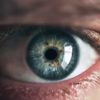What if you could test your eyesight by watching TV at home?

What if you could test your eyesight by watching TV at home?
What if, instead of going to a hospital for check-ups, people with glaucoma could test their eyesight by watching TV at home? Thanks to funding from Fight For Sight, Professor David Crabb and his team are making this ambitious idea a reality.
People with glaucoma can develop holes in their peripheral vision – the vision you’re using when you spot something ‘out the corner of your eye’.
Over time, losing peripheral vision makes tasks like driving or walking around the house challenging.
“This project wouldn't have got started, I don’t think, had we not had that original Fight For Sight funding.”
Testing peripheral vision
The gold-standard test for peripheral vision is called Standard Automated Perimetry. However, it can only be done in a hospital, and many people find it difficult.
What’s more, the results aren’t always reliable.
For example, someone can do the test in the morning and again in the afternoon but get different results.
“That causes issues when you’re trying to monitor a patient with glaucoma,” says Professor David Crabb from City University London – “you’ve got to convince yourself that their vision isn’t getting worse under the treatment.”
The variability of Standard Automated Perimetry doesn’t make this easy.

"They’re the fastest movement your body makes; you make more eye movements than your heartbeats"
Watching eye movements
David believes we could develop simpler, more reliable eye tests by using small cameras to track a person’s eye movements. You probably don’t notice them, but “they’re the fastest movement your body makes; you make more eye movements than your heartbeats,” David says.
In a previous study, David’s team noticed that people with holes in their peripheral vision made unusual patterns of eye movements compared to people with healthy vision.
So David applied to Fight For Sight for funding to answer a bold question: could you diagnose someone with glaucoma from their eye movements alone?
Eyecatcher – the 'Dad’s Army' test
David’s team monitored the eye movements of elderly people—some with glaucoma and others without—while they watched clips from TV programmes. The team used computers to spot differences in their eye movement patterns between the two groups.
The researchers found that their test, which they called ‘Eyecatcher,’ could indeed distinguish people with glaucoma from people with healthy vision—with an accuracy similar to Standard Automated Perimetry.
Eyecatcher made headlines worldwide and was nicknamed the ‘Dad’s Army test’ because one of the video clips used was from the BBC sitcom.
Eyecatcher Lite
The prototype Eyecatcher still needed specialised equipment in a university. So, with additional funding from Fight For Sight, David’s team developed a streamlined version, called ‘Eyecatcher Lite’, which could be done on a tablet computer.
The team tested Eyecatcher Lite with people waiting for their hospital glaucoma check-up. Again, they found the accuracy was very similar to Standard Automated Perimetry.
In the short term, the team want to have Eyecatcher Lite used in clinical trials of new glaucoma treatments. David’s colleague Dr Pete Jones, who led the Eyecatcher work, has started a spinout company to make this happen.
Easier and accurate eye tests
David’s long-term vision is that people with glaucoma, or other conditions, could do eye tests with Eyecatcher while watching TV at home.
The initial project was a high-risk idea, David reflects. But he feels that, thanks to a relatively small investment, the huge potential of that idea will soon be reached. “Quite simply, this research would not have happened without Fight For Sight.”
Stay in the loop
on eye research breakthroughs, inspiring real life stories and more...



